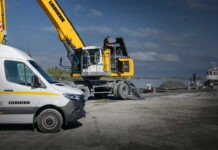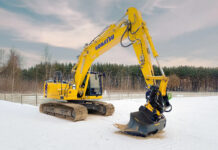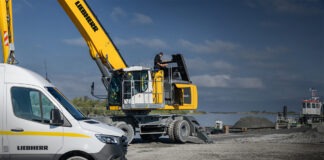Bart Vingerhoets, Senior Commercial Manager at Komatsu Smart Construction
Internet connected hardware and artificial intelligence (AI) are becoming increasingly important in the construction and earthmoving industry, particularly site management. With advancements in technology, machinery such as excavators are becoming smarter, ultimately enhancing safety and efficiency on construction sites.
Bart Vingerhoets, Senior Commercial Manager at Komatsu Smart Construction, offers his insight on the benefits of smart technology in construction, the potential applications for this in excavator machinery and how these innovations are changing the dynamics of job sites.
Have you found users asking for more technology on their excavator? If so, what are they specifically asking for?
There has been a significant push towards digitisation by excavator operators, construction companies and governments. Technology is not only improving the efficiency of excavators but also aiding in increasing safety.
The earthmoving industry as a whole understands the benefits of technology. In Europe, some regions were initially priced out of being early adopters of new innovations. However, with hardware solutions becoming more cost-efficient, adoption rates are on the rise. Smart Construction has seen this firsthand, as 38 percent of its 3D Machine Guidance system sales took place in East and South Europe.
Customer demands vary depending on the region and client size. Many technologies that were initially adopted in West and North European sites are now being adopted elsewhere. In the early adopter countries, the main concern is safety, along with a productivity increase.
At its core, digitally enabled hardware on excavators and machinery helps teams work more efficiently, make better decisions, and deliver stronger project outcomes. For example, Komatsu’s Smart Construction Dashboard creates a digital version of the job site, showing live data on materials, measurements and potential issues.
What do users want the technology for?
Construction companies are seeking technological advancements to enhance profitability, save time, and reduce costs. Every year, businesses become more eager to improve risk management, leading to enhanced safety on construction sites, which can be facilitated by digital solutions.
Excavator operators, who see the direct benefit of enhanced technology, experience numerous advantages from incorporating digital solutions into their day to day work, such as time savings for site managers, enhanced problem solving and improved efficiency in data and file transfers. This enables managers to allocate more resources to oversee multiple sites and communicate with suppliers and clients. Furthermore, digital construction allows stakeholders to virtually inspect job sites, reducing the necessity for frequent on-site visits and creating a more efficient workforce with fewer errors and rework.
For example, Komatsu Smart Construction’s Intelligent Machine Control excavators have semi-automatic control features that eliminate the possibility of over-digging, avoiding costly re-work, especially integral when working with various material layers. Teams can respond quickly, solve problems as they arise, and maintain progress without unnecessary delays.
Do you anticipate users’ tech needs changing in the next five years? Will they stay the same until there is a new wave of technology developments?
The technology needs of excavator users and the construction workforce is expected to naturally evolve over the next five years due to several emerging trends and advancements in construction and heavy machinery technology.
Due to the growth in digital twin technologies, we believe excavators and other earth movement equipment will take a pivotal role in capturing survey-grade data. Having every bucket or blade move represented in a highly accurate model, such as Komatsu Smart Construction Intelligent Machine Control, means all members of the workforce can access remotely, adding significant productivity gains.
In 2025 and beyond, we can expect the adoption of smart technology and the use of AI on construction sites to continue to rise as more cost effective options hit the market. In fact, the global AI in construction market was estimated at £1.3 billion in 2023 and is projected to reach £9.1 billion by 20301.
The digitalisation across earthmoving and construction is making notable strides in line with the increased adoption of technology. Komatsu Smart Construction recently announced that its Remote solution will now be available as a standard with all purchases of Komatsu-branded guidance and control systems, recognising the brand’s ongoing efforts to prioritise interoperability and ease of digital transformation, regardless of company size.
Data analytics and decision support
The ability to gather and analyse data from various sources is becoming increasingly important. Advanced analytics can offer insights that aid in planning, risk management, and decision-making, ultimately enhancing operational efficiency and effectiveness.
Smart Construction’s Remote allows users to send new design data to machines in the field, or remotely support operators, without travelling to the jobsite, making data transfer take significantly less time than before whilst also reducing fuel usage.
Are the users who are currently using specific technologies coming back and asking for additional tech solutions?
Smart Construction reported a 44 percent adoption increase in its software as a service (SaaS) technology from FY2023 to FY2024, highlighting a rising demand for software in construction. Users have found that our solutions greatly improve their site’s performance and profitability, with many stating they couldn’t work without them anymore. Smart Construction solutions work well independently but have enhanced capabilities when used together, for example, Dashboard and 3D Machine Guidance.
We spend significant time with our customers while they are on the job. This leads to a close relationship between the Smart Construction team and the customer base, so we often hear what our customers are thinking. We use this information to see how we can assist in bringing their ideas to life by presenting new solutions, building new features, or products.
As a result, in each country we operate in, we have customers who are aware of our development roadmap and actively ask to test the new products due to our previous performance, such as the latest version of Edge, which launched last year.
As the industry continues to evolve and new technology develops and rolls out, we can expect our users to want additional technology solutions that work alongside our existing solutions.
To find out more about digital solutions, visit: smartconstruction.io











